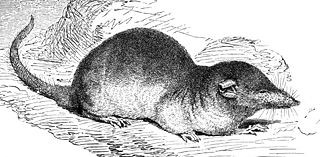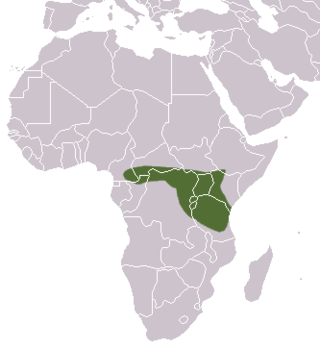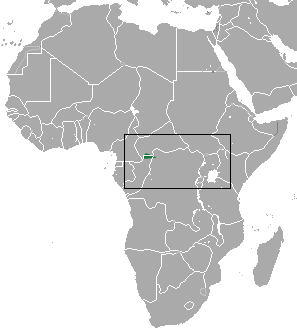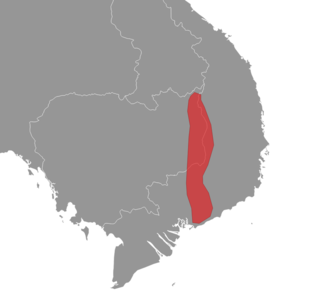
The white-toothed shrews or Crocidurinae are one of three subfamilies of the shrew family Soricidae.

The genus Crocidura is one of nine genera of the shrew subfamily Crocidurinae. Members of the genus are commonly called white-toothed shrews or musk shrews, although both also apply to all of the species in the subfamily. With over 180 species, Crocidura contains the most species of any mammal genus. The name Crocidura means "woolly tail", because the tail of Crocidura species are covered in short hairs interspersed with longer ones.
The Mount Oku hylomyscus is a species of rodent in the family Muridae. Found only on Mount Oku, Cameroon, in tropical Central Africa, its natural habitat is tropical moist montane forests. It has a very small range and is threatened by habitat destruction, so the International Union for Conservation of Nature has rated its conservation status as being "critically endangered".

The Asian gray shrew is a species of mammal in the family Soricidae. It is found in Bhutan, Cambodia, China, India, Laos, Malaysia, Myanmar, Nepal, Pakistan, the Philippines, Thailand, and Vietnam. It is one of the commonest species within its range and the International Union for Conservation of Nature has assessed its conservation status as being of "least concern".

Hildegarde's shrew is a recently discovered shrew, described in 1904. Considered by some authorities to be a subspecies of the Peters's musk shrew, it is now recognised as a separate species, with a diploid chromosome number of 2n = 52.

Horsfield's shrew is a species of mammal in the family Soricidae found in Cambodia, China, India, Japan, Laos, Nepal, Bhutan, Sri Lanka, Taiwan, Thailand, and Vietnam.

The bicolored shrew or bicoloured white-toothed shrew is a species of mammal in the family Soricidae. It is found in eastern, central and southern Europe and in western Asia. It is a nocturnal species and feeds on insects and other small creatures. Several litters of young are born during the warmer months of the year in a nest of dry grasses in a concealed location.

The swamp musk shrew, or musk shrew, is a species of mammal in the family Soricidae. It occurs in Angola, Botswana, Democratic Republic of the Congo, Mozambique, Namibia, South Africa, Eswatini, Zambia and Zimbabwe. Its natural habitat is swamps, and it is a common species in suitable habitats, with the International Union for Conservation of Nature listing it as being of "least concern".

The Sri Lankan long-tailed shrew is a species of mammal in the family Soricidae. It is endemic to Sri Lanka. It is threatened by habitat loss.

The Ugandan musk shrew is a species of mammal in the family Soricidae. It is found in Uganda, the Democratic Republic of Congo and the Central African Republic. Its range, population size and habits are poorly known.

The African giant shrew is a species of white-toothed shrew. It also is known as, Mann's musk shrew, Euchareena's musk shrew, or Olivier's shrew. It is native to Africa, where it has a widespread distribution and occurs in many types of habitat. Its natural habitats are subtropical or tropical dry forest, subtropical or tropical moist lowland forest, subtropical or tropical moist montane forest, dry savanna, moist savanna, arable land, rural gardens, urban areas, and heavily degraded former forest. In the Nile Valley it is found near human habitation, where it is considered to be a pest. It is a common species and is listed by the International Union for Conservation of Nature as being of "least concern".

The Egyptian pygmy shrew or sacred shrew is a species of mammal in the family Soricidae. It is endemic to Egypt. Its natural habitat is arable land. It is threatened by habitat loss, partially caused by the construction of the Aswan Dam. They are 48–62 mm (1.9–2.4 in) in length and weigh 7 g (0.25 oz), making them one of the smallest shrews in Egypt.

Whitaker's shrew is a species of mammal in the family Soricidae. It is found in Western Sahara, Algeria, Morocco, Tunisia. Its natural habitats are subtropical or tropical dry shrubland, rocky and sandy coasts. It is a fairly common species and the International Union for Conservation of Nature has rated its conservation status as being of "least concern".

Pearson's long-clawed shrew is a species of mammal in the family Soricidae. It is the only species within the genus Solisorex. It is endemic to Sri Lanka. Its natural habitats are subtropical or tropical dry forests and lowland grasslands. It is threatened by habitat loss. It is named after Joseph Pearson FRSE, Director of the Columbo Museum 1910-1933 who found it on 1 January 1924.

Crocidura phanluongi is a species of shrew in the genus Crocidura from southern Vietnam and nearby Cambodia. It is a somewhat small, gray shrew with an ecologically diverse distribution.

The Kalinga shrew mouse is a rodent of the genus Soricomys found in the northern province of Kalinga, island of Luzon, in the northern Philippines.

The Panay shrew is a species of shrew from the Philippines.
Crocidura kegoensis, also known as the Ke Go shrew or Ke Go white-toothed shrew, is a species of shrew in the genus Crocidura described in 2004. It is smaller than other Crocidura species known from Vietnam, brownish-grey in colour with black markings on the muzzle. Its hair is short. The holotype was found in the Ke Go Nature Reserve, in Vietnam's Ha Tinh province, at an altitude of about 200 m.
The Sanetti shrew or Bekele's shrew is a species of mammal in the family Soricidae. It is endemic to Ethiopia.
Sokolov's shrew is a species of mammal in the family Soricidae. It is endemic to Vietnam.
















